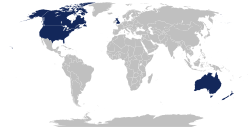Mass surveillance in the United States
The practice of mass surveillance in the United States dates back to wartime monitoring and censorship of international communications from, to, or which passed through the United States.
After the First World War and the Second World War, the surveillance continued, by programs such as the Black Chamber and Project SHAMROCK. The formation and growth of federal law-enforcement and intelligence agencies such as the FBI, CIA, and NSA helped surveillance, such as the COINTELPRO projects which currently exist in secret.
A series of media reports in 2013 revealed more recent programs and techniques employed by the US intelligence community. Advances in computer and information technology allow the creation of huge national databases that facilitate mass surveillance in the United States.[1][2]
Mass Surveillance In The United States Media
At the request of the U.S. Army, those who protested against the Vietnam War were put on the NSA's "watch list".
From 1940 until his death in 1966, the American business magnate Walt Disney served as a "S.A.C. Contact" (trusted informant) for the U.S. government to weed out communists and dissidents from the entertainment industry, according to documents obtained by The New York Times.See also: Hollywood blacklist
The September 11 attacks on the World Trade Center and the Pentagon led to major reforms of U.S. intelligence agencies, and paved the way for the establishment of the Director of National Intelligence position.
On 1 January 2006, days after The New York Times wrote that "Bush Lets U.S. Spy on Callers Without Courts,
Official seal of the Information Awareness Office – a U.S. agency which developed technologies for mass surveillance
References
- ↑ Glenn Greenwald. (31 July 2013). "XKeyscore: NSA tool collects 'nearly everything a user does on the internet'". The Guardian. Retrieved 2 August 2013.
- ↑ Mui, Ylan (29 July 2013). Growing use of FBI screens raises concerns about accuracy, racial bias. https://www.washingtonpost.com/business/economy/growing-use-of-fbi-screens-raises-concerns-over-accuracy-racial-bias/2013/07/29/d201ecda-f49f-11e2-aa2e-4088616498b4_story.html. Retrieved 2 August 2013.







